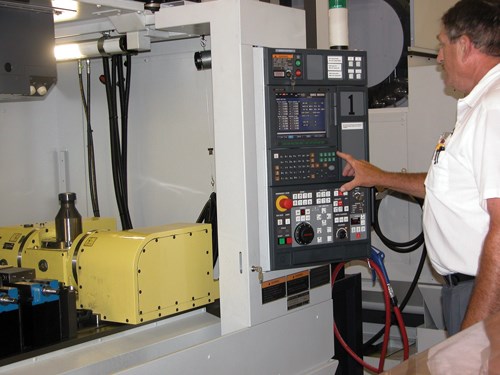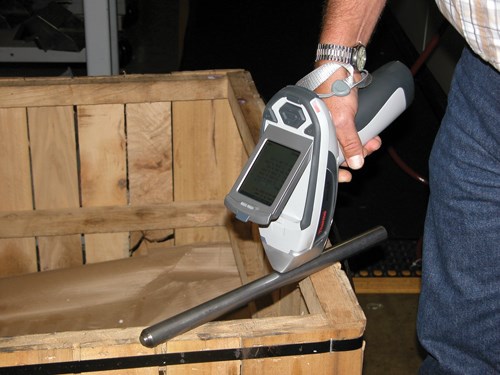Shop Enjoys Five-Axis Benefits Without The Cost
Integrating Lyndex-Nikken rotary tables into three-axis Mori Seiki VMCs provided this shop with five-axis capability at a fraction of the cost of a new five-axis machine.
Cutting complex contours, meeting tight tolerances and reducing setups are just a few of the most celebrated benefits of five-axis machine tools. Over time, these complex machines have become smaller, more affordable and increasingly popular. However, they still can take a sizeable chunk out of any shop’s pocketbook. What if there were a way to enjoy the advantages of five-axis machining without the expense?
According to machine tool accessory manufacturer Lyndex-Nikken, this can be accomplished by incorporating a five-axis rotary table into a three-axis machine. A case in point is C&A Tool, a manufacturer serving the mold and die, aerospace, transportation and other industries. Integrating Nikken 5AX-200II rotary tables with Mori Seiki NV-5000 VMCs not only enabled simultaneous five-axis cutting at less cost than a new five-axis machine tool, but also improved flexibility.
What began 40 years ago from vacant retail shops in downtown Churubusco, Indiana has grown into C&A Tool’s industrial campus, which consists of a 180,000-square foot headquarters, a 344,000-square foot plant and 14 other buildings. The company also operates a 105,000-square-foot facility in nearby Auburn, Indiana. The Churubusco campus possesses a certain old-world charm—its facilities feature a distinctive Alpine look, resembling a sprawling Bernese Swiss village.
Belying this traditional appearance, however, the manufacturing area is home to a variety of advanced machinery and equipment. The company’s headquarters contains eight ergonomic pods designed for manufacturing flexibility and expandability. Raw stock is tested for purity and consistency in the material preparation pod before moving on to other pods dedicated to milling, grinding, turning and other work, including laser sintering. For quality control, the pods include metrology labs with equipment such as Carl Zeiss CMMs and Zygo interferometers. Material is delivered via a central corridor that is wide enough to accommodate lift trucks for easy transport.
Equipment in these pods enables the shop to produce jobs ranging from one-off prototype work to 200,000-piece lots of precision-machined fuel-injection tips for the automotive industry. “C&A Tool is the largest provider of prototype-through-design diesel fuel systems, but we’re also making mouthpieces for clarinets and air cylinders for paintball guns,” says Dick Conrow, founder and owner. “What keeps us strong is that we do a little work for a lot of people."
Migrating into surgical components was a natural step for C&A because of the shop’s ability to meet tight tolerances, Mr. Conrow says. One such component, a titanium carbide housing for an orthopedic spinal implant, makes up the majority of the work at the company’s recently purchased Auburn facility. The implant, which is inserted into a cervical vertebra to provide mobility for patients, requires tolerances of less than 25 microns and surface finish of 0.32 Ra.
Efforts to ensure cost-effective, quality production of this implant spurred the shop to consult with Dave Werblo from distributor Ellison Technologies (Fishers, Indiana), who suggested incorporating five-axis rotary tables on three-axis machines. Per his recommendation, the shop purchased 16 Mori Seiki NV-5000 VMCs, each equipped with a 5AX-200II Lyndex-Nikken rotary table. This reduced machinery investment costs by 50 percent.
“The VMCs can now perform full five-axis, simultaneous milling exactly like a factory-built five-axis machine—to the same accuracy and at a fraction of the cost,” says Steve Baier, regional manager at Lyndex-Nikken. Mr. Baier adds that in addition to the extra expense involved, investing in dedicated five-axis machines would have been a less versatile solution. On the other hand, adding five-axis rotary tables to three-axis mills provides the flexibility to use the machine for both three- and five-axis work, he explains. C&A’s Shane Manth adds that it takes only an hour to remove the table if three-axis work is required. Moreover, he notes that C&A operators can mount standard vises and fixtures for parts as large as 10 inches with the rotary table still in place.
Additionally, integrating rotary tables with the VMCs has enabled the shop to complete the implant machining process in fewer steps. “Because everything is based on centerline rotation, this arrangement has eliminated two wire EDM operations, centerless grinding operations and the need for a qualified blank,” says C&A’s Boyd Pruitt.
The 5AX-200II CNC rotary table features a drop trunion and clamping torque of 588/490 Nm. With a face-plate diameter of 200 mm and a maximum workload of 176 pounds, the device is equipped with a custom, carbide worm system. This system uses a carbide worm screw and an ion-nitrided worm wheel, as opposed to a bronze or bronze alloy actuation mechanism. This can reduce friction and wear by a factor of eight, the company says. The worm screw is composed of a less-brittle, V-grade form of carbide, while the worm gear is ion-nitrided to a depth of 0.1 mm and an external surface hardness of 68 Rc. Combined with a steel way that is hardened to between 58 and 60 Rc, these properties are said to enhance rigidity and longevity.
“We chose the rotary tables for their accuracy, repeatability, low maintenance and good name in the industry,” Mr. Manth says. “The integration of the tilt tables into the machines is so clean you can’t tell it’s not a factory install.”
Related Content
Understanding Swiss-Type Machining
Once seen as a specialty machine tool, the CNC Swiss-type is increasingly being used in shops that are full of more conventional CNC machines. For the newcomer to Swiss-type machining, here is what the learning curve is like.
Read More10 Things to Know About Creep-Feed Grinding
Because of the high material removal rate creep-feed grinding can deliver in challenging materials, grinding might not be just the last step in the process—it might be the process.
Read MoreGrinding Wheel Safety: Respect The Maximum Speed
One potential source of serious injury in grinding comes from an oversight that is easy to make: operating the wheel in an over-speed condition.
Read MoreThreading On A Lathe
The right choices in tooling and technique can optimize the thread turning process.
Read MoreRead Next
The Cut Scene: The Finer Details of Large-Format Machining
Small details and features can have an outsized impact on large parts, such as Barbco’s collapsible utility drill head.
Read More3 Mistakes That Cause CNC Programs to Fail
Despite enhancements to manufacturing technology, there are still issues today that can cause programs to fail. These failures can cause lost time, scrapped parts, damaged machines and even injured operators.
Read More.jpg;maxWidth=970;quality=90)









.jpg;maxWidth=300;quality=90)







.png;maxWidth=300;quality=90)










.jpg;maxWidth=970;quality=90)